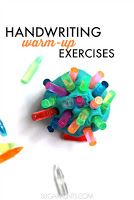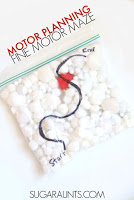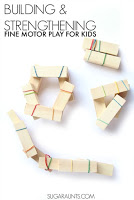In this blog post, we’re covering wrist extension and wrist stability…and wrist extension toys that support these motor skills through play. You’ll want to check out our wrist range of motion exercises for another hands-on wrist extension activity that kids love. The fine motor skills happening with these activities are huge. And, when the wrist is in optimal positioning, we can support the manual dexterity goals needed for functional skills.
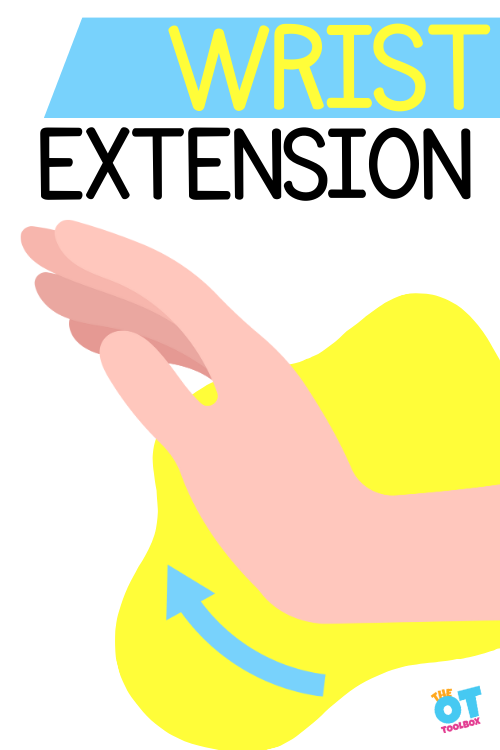
Wrist extension plays a big role in functional tasks, including manipulating objects, ROM, and strength.
Wrist Extension
Before we get to the wrist extension activities, let’s talk about what wrist extension means and how an extended wrist is needed for wrist stability (both as an active muscle group AND as a stabilizer against wrist flexion).
Wrist extension refers to the movement of the wrist as it bends back toward the back of the hand. When the wrist moves, there is a large range of motion and the tendons of the wrist provide great strength that offer structural stability for use of the fingers in grasping.
There are several distinct joints that make up the wrist (did you realize that there were more than one joint in the wrist?!) The joints that make up the wrist include:
- Radiocarpal joint- this is the joint at the end of the radius which articulates against carpal bones, as well as the end of the ulna bone.
- Midcarpal joint- This joint space is between the proximal and distal carpal bones in the base of the hand. While the carpal bones might seem like they are part of the hand and not involved with the wrist, these bones actually attach to ligaments which play a role in wrist motions (flexion, extension, and radial and ulnar abduction)
- Carpometacarpal joints- The base of the carpometacarpals articulate with one another and with the distal carpal bones. The ligaments that attach here play a role in hand and wrist stability. However, the CMC joint of the base of the thumb has a bigger role in wrist extension and stability.
Range of motion in the wrist is dependent on the motion of the hand and fingers. This is because when the hand and fingers are relaxed, the wrist can fully flex (bend at the wrist toward the palm). The wrist can only reach full extension when the fingers are flexed into a fist. This is called close-packed. When this position is achieved, the wrist is in it’s most stable position.
Wrist Extension in Grasping
The strongest grasp will occur when the wrist is extended. If the hand is grasped when the wrist is flexed, you’ll notice a much weaker grip strength.
Why?
Because of the way the muscles in the forearm cross over the wrist. The long finger flexor muscles have an attachment in the forearm and pass over the the wrist. This is where we see wrist stability.
If the wrist flexes while the hand grasps into finger flexion, it’s actually impossible to fully flex the fingers.
You might have seen a child who holds their pencil with a bent wrist and curled up fingers. Maybe you see a kiddo who struggles to hold a fork or spoon.
They’ve probably got their elbow super flexed and their shoulder forward.
Maybe you have a kiddo who fumbles with buttons and zippers or shows weakness in grasping items. Perhaps you have an OT client who bends their wrist forward when they are lacing beads or other fine motor tasks.
When the wrist is flexed (bent forward towards curved fingers in a grasp), there is little chance of fine motor dexterity. A flexed wrist in functional tasks limits use of the fingers due to the tendons of the fingers being shortened as they work to stabilize the wrist. The fingers just can’t move like they are supposed to.
An example of this in action is when we snap our fingers. It’s possible, but it’s much harder to snap your fingers when your wrist is flexed forward. When you extend your wrist back into extension, it’s much easier to make a loud and crisp snapping sound with your fingers.
Wrist stability toys
Did you know you can support proximal stability and distal mobility through wrist extension toys? It’s true! There are toys and games that target wrist stability so the distal fingers and thumb can manipulate objects with coordination and dexterity.
A pediatric Occupational Therapist knows that with function comes FUN. And these wrist stability toys are powerful occupational therapy toys that build development and support coordination.
So, when your child’s OT is looking for activities to build the skills needed for development, they know how to add in creative activities that promote independence. Today, I’ve got fun ways to work on fine motor skills with a functional grasp, specifically the extended wrist.
There are many exercises and activities that can be done to build the stability of the wrist so that it maintains a slightly extended position during fine motor activities.
I’ll be sharing some DIY creative ideas soon (so stay tuned!) but for now, here are 10 Must Have toys to build wrist stability and extended wrist:
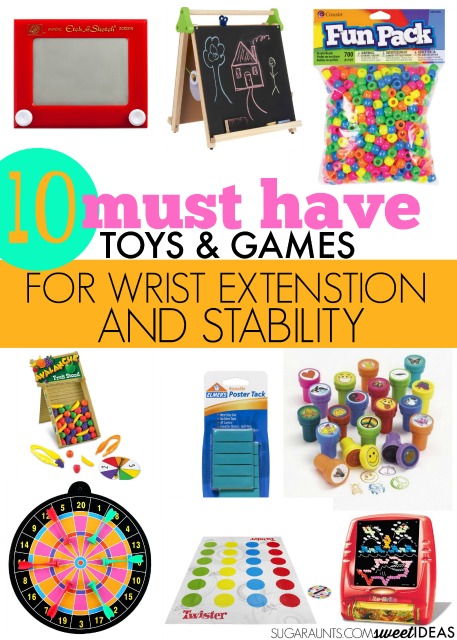
Toys to Promote an Extended Wrist and Functional Grasp During Fine Motor Activities
These wrist extension toys support a stable wrist. For the child that writes with a flexed wrist, or tries to tie their shoes with bent, flexed wrists, you’ll see less dexterity and mobility in the fingers. Using wrist extension activities with toys can make this strengthening task more fun…and functional!
1. Lite Brite (affiliate link) Position this old school toy on a slightly elevated surface to promote an extended wrist while managing the small pegs within the hand and with a tripod grasp.
2. Table Top Easel– (affiliate link) This one is double sided to allow for chalk, dry erase markers, and has a clip for attaching paper. Use the easel for writing, drawing, painting, coloring, chalking, and games like Hand Man to make strengthening fun.
3. Avalanche Fruit Stand Game– (affiliate link) This game is a fun way to build fine motor skills with an extended wrist.
4. Dartboard– (affiliate link) Tossing darts encourages an extended wrist while holding the darts. This set comes with magnetic darts, which is great for kids.
5. Pop Beads– (affiliate link) The small size of pop beads promotes dexterity of the fingers as well as resistance to push the beads together. Encouraging the child to do this task with both elbows on a table surface encourages an extended wrist.
6. Stamps– (affiliate link) Grab a set of small rubber stamps or any stamp that has a small handle. Tape a piece of paper to the wall or clip it to an easel. Holding the handle while stamping on a vertical surface promotes a functional wrist position.
7. Twister game– (affiliate link) Any game or activity that is done with the child extending their wrist as the press their upper body weight through the arm is a great strengthening exercise for wrist stability.
8. Beads– (affiliate link) Threading beads with a string or plastic cord encourages and extended wrist with fine motor dexterity. Beads can be found in various sizes to meet the needs of the child.
9. Wall Sticky Tack– (affiliate link) Sticky tack? Really! Use it to hand paper, mazes, tic tack toe boards, connect the dot pages, and coloring sheets right to the wall! You can hang paper on the windows, like we did to really work on handwriting with a see-through effect. Writing on the wall is a great way to build wrist stability and promote an extended wrist.
10. Etch-A Sketch– (affiliate link) Another classic toy, the Etch-A Sketch is perfect for building an extended wrist. Prop it up on a slanted position and be sure to place it upside down so the knobs are at the top.
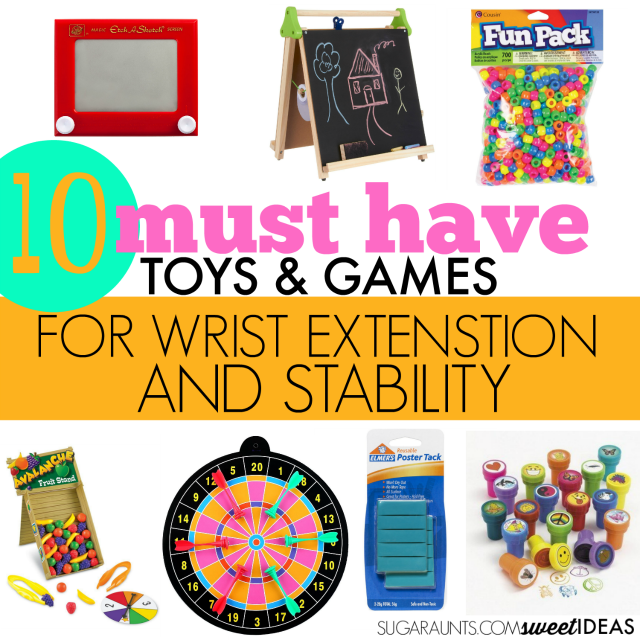
More Fine Motor Skills you will love:
- Handwriting Warm Up Exercises
- Homemade Lacing Cards
- Motor Planning Fine Motor Maze
- Hand Strengthening Building Activity
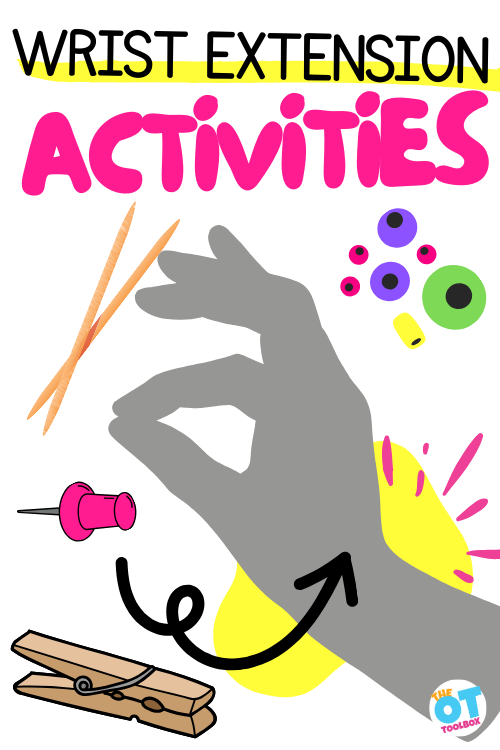
Wrist Extension Activities
The toys we listed above are fun ways to build and develop wrist extension. You can also try these activities to support wrist stability through extension:
- Playing on a vertical surface such as drawing on a chalkboard
- Window clings
- Fingerpainting on a window
- fingerprint art
- Toothpick art or pushpin art on a slanted or vertical surface
- Using a slantboard for writing
- Hand clapping games
- Finger games
- Bead activities such as threading beads
- Shoe tying and tying knots with string or pipe cleaners
- Snapping your fingers
Working on fine motor skills, visual perception, visual motor skills, sensory tolerance, handwriting, or scissor skills? Our Fine Motor Kits cover all of these areas and more.
Check out the seasonal Fine Motor Kits that kids love:






Or, grab one of our themed Fine Motor Kits to target skills with fun themes:
- Frogs Fine Motor Kit
- Unicorns Fine Motor Kit
- Vehicles Fine Motor Kit
- Apple Fine Motor Kit
- Back to School Kit
- Sports Fine Motor Kit
- Outer Space Fine Motor Kit
- Fairytale Fine Motor Kit
- Plus more in our shop!
Want access to all of these kits…and more being added each month? Join The OT Toolbox Member’s Club!
Wrist Extension Exercises Handout
We have put together a nice resource for you…a free handout on wrist extension exercises. These activities are designed to improve wrist stability and strength needed for fine motor dexterity and handwriting.
Enter your email address into the form below. We’ll send you a copy of this handout. The printable is also found in The Membership Club under therapy tools.
Let us know how you use this printable list of exercises for wrist mobility and stability!

Colleen Beck, OTR/L has been an occupational therapist since 2000, working in school-based, hand therapy, outpatient peds, EI, and SNF. Colleen created The OT Toolbox to inspire therapists, teachers, and parents with easy and fun tools to help children thrive. Read her story about going from an OT making $3/hour (after paying for kids’ childcare) to a full-time OT resource creator for millions of readers. Want to collaborate? Send an email to contact@theottoolbox.com.


